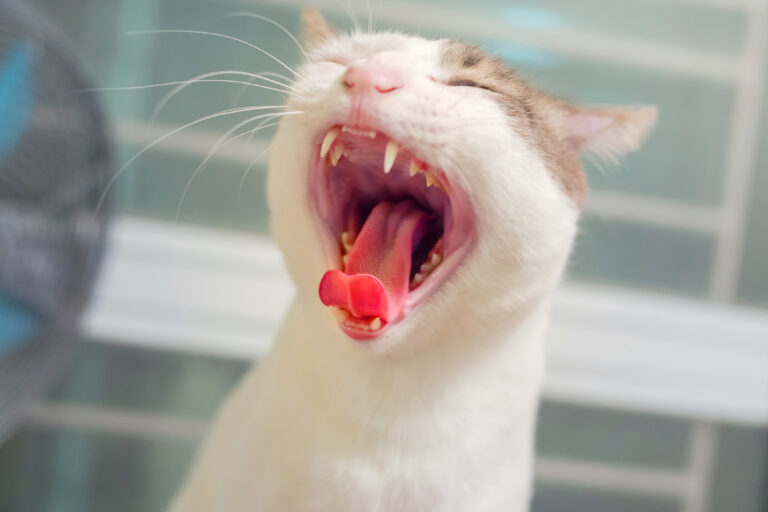Gingivitis is the term for inflammation of the gums, which mostly manifests itself through redness and swelling of the mucous membrane surrounding the teeth. This usually painful gum disease is very common amongst cats and can be triggered by numerous causes. Thus, a detailed diagnosis is important in order to treat it correctly and at an early stage.
What causes gum inflammations in cats?
Along with gum inflammations caused by the impalement of foreign bodies (e.g. blades of grass), general inflammations of the periodontal apparatus (periodontitis) or other organ diseases (e.g. with renal insufficiency), infectious diseases are amongst the most well-known triggers of gingivitis in cats.
In veterinary circles, the disease is also divided into different forms of gingivitis, some of which differ greatly in their origins and symptoms:
- Catarrhal gingivitis is derived from the word catarrh, which is a mucosa irritation accompanied by production of a watery secretion. It typically manifests itself through severe redness and swelling of the gums. This type of gum inflammation is usually of unspecific origin and emerges as an attendant symptom of a bacterial infection due to gum diseases like tartar or periodontitis (inflammation of the periodontal apparatus). With cats, infection with feline immunodeficiency virus (FIV), also known as cat AIDS, plays a big role too.
- Erosive gingivitis is based on damage to the superficial mucous membrane layer. Viral infectious agents like feline panleukopenia virus (FPV), feline caliciviruses (FCV) or feline herpesvirus (FHV-1) are known causes with cats.
- Eosinophilic gingivitis (eosinophilic granulocytes = immune cells) is quite common with cats, although the primary cause is unknown in most cases. An allergic hypersensitivity reaction based on feline eosinophilic granuloma complex (EGC) is mostly assumed, which is typically recognised by inflammatory nodules, known as granuloma.
- Feline plasma cell gingivitis is probably of idiopathic origin, since there is not yet any known cause. However, there is presumably a connection to viral infectious agents like feline caliciviruses (FCV), feline leukaemia virus (FeLV) and feline immunodeficiency virus (FIV) as well as bacterial infections. This gum inflammation can be recognised by pronounced reddening of the gums and the presence of tumours (gingival hyperplasia) and sores (ulcerations).
Symptoms
Along with the typical distinguishing features described above, gum inflammations can lead to further concomitant symptoms from a certain degree of severity:
- Usually severe pain: loud noises when eating or touching the inflamed areas, worsened general condition, tiredness, reluctance to exercise
- Reduced appetite and weight loss
- Increased saliva and bad breath
- Bleeding and discolouration of the teeth (e.g. due to plaque)
How is gingivitis recognised with cats?
If a cat eats less or redness or bleeding can be recognised, a trip to the vet is usually advisable. During the owner interview (anamnesis), the vet can already rule out infectious diseases triggering gingivitis based on the cat’s vaccination status. There is always a general clinical examination of health check-up afterwards. The oral cavity is then thoroughly examined by the vet, including the teeth and gums:
In many cases an anaesthetic is necessary if the cat won’t allow its mouth to be examined or the cause is suspected to be found in the back of the mouth. Imaging procedures like X-rays can also be necessary in order to more closely inspect bony structures like the teeth or jaw for changes.
If a cat isn’t vaccinated against certain viral pathogens (e.g. feline caliciviruses), specific tests (e.g. antigen or antibody tests) also make sense.
What are the treatment options?
Treatment of a gum inflammation in cats must on one hand be specifically against the cause itself and on the other hand be supportive, i.e. to improve symptoms:
Different causes can be treated as follows:
- Foreign bodies: surgical removal if necessary
- Tumours: operation, radiotherapy or chemotherapy
- Viral infectious agents: virostatic agents if necessary
Cats can also be helped with the following supporting measures:
- Helps an extraction of one or more teeth
- Medication like painkillers, anti-inflammatories (if necessary cortisone) as well as immune-strengthening substances or antibiotics against secondary bacterial inflections following a resistance test
- Wound hygiene through mouth rinsing (e.g. with chlorhexidine solution)
- Bolstering the immune system with vitamin preparations and a balanced diet (wet or liquid food should be offered in the case of pain or problems chewing)
- Professional teeth cleaning to combat dental diseases
What is the prognosis?
Not all gingivitis necessarily has to lead to severe pain or complications such as exposed tooth roots, teeth falling out or other parts of the mouth mucosa becoming inflamed (stomatitis). Despite this, it should be examined by a vet at an early stage so that it doesn’t become chronic and to allow previously unrecognised causes like infectious diseases to be acknowledged and treated.
How can gum inflammations be prevented with cats?
Unfortunately it is difficult to prevent the impalement of foreign bodies or the presence of tumours. In contrast, however, hygienic measures and vaccinations can prevent cats from gingivitis caused by infections. According to the guidelines for the vaccination of small animals issued by the Standing Vaccination Commission of Veterinary Medicine, there are vaccinations against the following feline-specific infectious agents:
- Recommended core vaccinations such as against feline herpesvirus (FHV-1), feline caliciviruses (FCV) and feline parvovirus (FPV): basic immunisation takes place at the age of 8, 12 and 16 weeks, as well as after 15 months and a booster vaccination can be carried out at intervals of one to three years depending on the producer
- Non-core vaccination against feline leukaemia virus (FeLV) e.g. for cats with outdoor access following a negative test result: from the age of 8 weeks at intervals of about one month as well as a final injection after a year
- There is currently no available vaccine for feline immunodeficiency virus (FIV)
